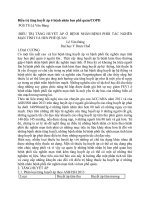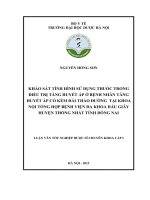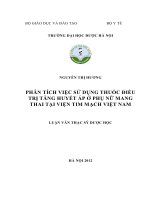ĐIỀU TRỊ TĂNG HUYẾT ÁP Ở NGƢỜI CÓ TAI BIẾN MẠCH NÃO
Bạn đang xem bản rút gọn của tài liệu. Xem và tải ngay bản đầy đủ của tài liệu tại đây (2.42 MB, 39 trang )
GS.TS. Huỳnh văn Minh, FACC, FAsCC
Phó Chủ tịch Hội Tim mạch Việt nam
Chủ tịch Phân hội THA Việt nam
ĐIỀU TRỊ TĂNG
HUYẾT ÁP
Ở NGƢỜI CÓ
TAI BIẾN
MẠCH NÃO
1
WHO CVD Atlas. 2002. WHO Stroke Atlas. 2002.
Tử vong do đột quị tại Châu Á
2
3
The Continuum of Stroke Care
ASA Guidelines. Stroke 2013
Guidelines Ischaemic Stroke 2008
Dự phòng thứ phát đột qui
Management of vascular risk factors
Antithrombotic therapy
Surgery and angioplasty
Dự phòng thứ phát đột qui
Warlow C, et al. Lancet 2003;362:1211–24
Patients who have suffered a stroke or TIA remain at an increased risk
of:
A further stroke (about 5% per year, maybe 10% in the first year)
MI (2–3% per year) Touze E et al. Stroke 2005;36:2748–55
Stroke, MI or vascular death (about 7% per year)
Risks higher in the immediate period following a stroke/TIA:
Risk of further stroke may be 12% in first 30 days post stroke
Risk of stroke 10% in first 90 days post TIA
Even higher risks reported in some studies
e.g. Coull AJ et al BMJ 2004;328:326–9
TIA = transient ischaemic attack MI = myocardial infarction
Ích lợi điều trị HA tâm thu
6
4 Vấn đề
1. Có nên giảm huyết áp?
2. Khi nào bắt đầu?
3. Giảm bao nhiêu? Huyết áp mục tiêu?
4. Lựa chọn thuốc?
1. Có nên giảm huyết áp?
8
• CBF = CPP / CVR
(Cerebral Blood Flow) : (Cerebral Perfusion Pressure) / (CerebroVascular Resistance)
• CPP = MAP – Venous Back Pressure
• CPP # MAP (Mean Arterial Pressure)
CBF = MAP / CVR
(50ml/100g/minute) (60-150mmHg)
Thay đổi MAP làm thay đổi trực tiếp CBF
Cân bằng lợi hại khi hạ HA sau thiếu máu não
Penumbra
Hemorrhagic
Transformation
Guidelines Ischaemic Stroke 2008
Kiểm soát huyết áp
• Antihypertensive drugs reduce stroke recurrence
risk after stroke or TIA (RR 0.76; 95%CI 0.63-0.92)
1
• Target BP level and reduction should be
individualized
• The reduction in stroke occurs regardless of
baseline BP and type of stroke
2
1: Rashid P et al.: Stroke (2003) 34:2741-8
2: PROGRESS group: Lancet (2001) 358:1033-41
Giảm MAP> 16% sẽ làm ảnh hưởng đến áp lực tưới máu não
13
Relative Risk of
Stroke Death
<112
<71
Nguy cơ tử vong do đột quị do HA: Nghiên cứu
MRFIT
1 2 3 4 5 6 7 8 9
10
Decile
112
71
118
76
121
79
125
81
129
84
132
86
137
89
142
92
≥151
≥98
(Lowest 10%)
(Highest 10%)
SBP
DBP
Systolic Blood Pressure (SBP)
Diastolic Blood Pressure (DBP)
Stamler J, et al. Arch Intern Med. 1993;153:598-615; He J, Whelton PK. Am Heart J. 1999;138(Pt 2):211-219.
MRFIT = Multiple Risk Factor Intervention Trial; *P < 0.01; †P < 0.001.
* * *
*
*
†
†
†
†
†
Huyết Áp Tâm Thu giảm 10 mmHg,
Nguy cơ ĐQ tái phát giảm 28%
BMJ. 1996; 313: 147
Nghiên cứu PROGRESS
Perindopril protection against recurrent stroke study
Perindopril + indapamide
43% recurrent stroke
40% major vascular events
No significant benefit of agent given alone
Overall stroke risk reduction due to BP
Lancet. 2001 Sep 29;358(9287):1033-41
TIA & Stroke - Secondary Prevention
SORT A
Antiplatlet therapy
CVA - Aspirin 325mg within 24-48 hours
TIA - Aspirin (50-325mg), clopidogrel (75mg) or
ASA/Dipyridamole
Statins - LDL < 100
Antihypertensives - beyond acute period
Carotid Endarterectomy (CEA) >50% stenosis
Anticoagulation for cardioembolic disease
2013 Stroke management guidelines, AHA /ASA released in January 31, 2013
2. Bắt đầu điều trị HA khi nào ?
18
Blood pressure reduction is recommended in
persons who have had an ischemic stroke or
TIA are beyond the first 24 hours with
neurological symptoms stable.
(Class I; Level of Evidence A)
Stroke. 2011;42:227-276.
3. Giảm bao nhiêu? HA mục tiêu?
20
Mức hạ HA đối với bệnh nhân
10mmHg / HATT – hoặc 5mmHg / HATTr:
20–25% nguy cơ BMV.
40% nguy cơ đột quị.
1. Stamler J, Stamler R, Neaton JD, Blood pressure, systolic and diastolic, and cardiovascular risks. US population data, Arch Intern Med,
1993;153:598–615.
2. Asia Pacific Cohort Studies Collaboration, Blood pressure and cardiovascular disease in the Asia Pacific region, J Hypertens,
2003;21:707–16.
3. MacMahon S, Peto R, Cutler J, et al., Blood pressure, stroke and coronary heart disease. Part I, prolonged differences in blood
pressure: prospective observational studies corrected for the regression dilution bias, Lancet, 1990;335:765–74.
4.
• A target systolic blood pressure of 180 mmHg and
diastolic blood pressure of 100-105 mmHg is
recommended in patients with prior hypertension
• Patients without prior hypertension: 160-180/ 90-
100 mmHg
Cerebrovasc.Dis 2003; 16: 331
Target Blood Pressure
< 140/90 for most stroke patients
< 130/80 for patients with Diabetes
Time to reach : 3-6 months
AHA & ESO Guidelines: < 140/ 90 mmHg
<130/ 80 mmHg (diabetes)
JAMA 2003; 289: 2560
“A reasonable goal would be to lower
blood pressure by # 15% during the
first 24 hours after onset of stroke…”
Stroke 2007; 38: 1655
Đích HA cần kiểm soát
140/85mmHg for bilateral severe (>70%) internal carotid artery
stenosis a slightly higher target (eg systolic BP of 150 mmHg).
>55 yrs old or black patients of any age, the first choice: a
calcium-channel blocker or a thiazide-type diuretic.
< 55 yrs old: the first choice: angiotensin-converting
enzyme (ACE) inhibitor (or an angiotensin-II receptor
antagonist).
PROGRESS Study (Ischaemic & Haemorrhagic strokes)
Indapamide 2.5mg OM (Thiazide diuretic)
Perindopril 8mg.
RCP. National Clinical Guideline for stroke. 3
rd
edition, July2008.
NICE Hypertension CG 34, June 2006 SIGN Guideline No. 108, Dec
2008









